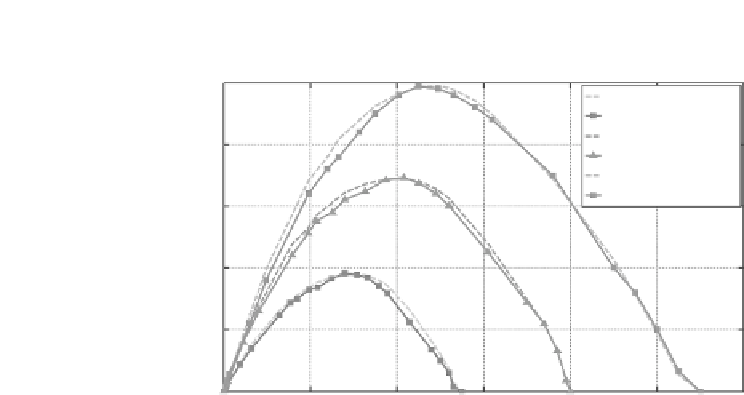Environmental Engineering Reference
In-Depth Information
Power Curve of a hermal Energy Harvester under Different
Temperature Differences
250
Simulated (∆
T
= 5)
Simulated (∆
T
= 5)
Measured (∆
T
= 5)
Simulated (∆
T
= 7)
200
Measured (∆
= 7)
Simulated (∆
T
= 10)
Measured (∆
T
= 10)
T
150
100
50
0
0
2
4
6
Voltage (V)
8
10
12
FIGURE 5.20
P-V curves of a thermoelectric generator at different thermal gradients.
the thermal contact faces, and both the electrical output voltage and current
with different loads connected were measured. This experiment was repeated
for various temperature differences in the range between 5 and 10 K, and the
experimental results are shown in
Figure 5.20
.
Referring to the power curve (P-V) shown in
Figure 5.20
, it can be seen that
the simulation results obtained using the model expressed in
Equation 5.10
are
comparable to the measurement results collected from the characterization of
the thermal energy harvester under varying temperature differences.
Figure
5.20
shows that the maximum obtainable power for each thermal gradient
corresponds to an output voltage of the thermal energy harvester, that is,
P
mppt,
T
=
5
K
=96
Wat4.5 V, and so on. This is
unlike the indoor SEH case, whereby all their power curves (P-V) peak near
a particular output voltage of the solar panel (see
Figure 5.17
).
However, this is not the case for another power curve (P-R) plotted for
SEH and TEH as shown in
Figures 5.18
and
5.21
, respectively. It can be ob-
served that the MPPs of the solar panel vary between the load resistances of
27 to 68 k
Wat2.8 V,
P
mppt,
T
=
10
K
= 247
, whereas the MPPs of the thermal energy harvester are fixed at
the internal impedance of the thermal energy harvester of 82 k
shows that when the load resistance matches the source resistance of the
thermal energy harvester, the harvested power is always maximum for dif-
ferent temperature differences. Because of that, it can be concluded from both
power curves in
Figures 5.18
and
5.21
that no common MPPT approach exists
between the SEH and TEH subsystems.








Search WWH ::

Custom Search